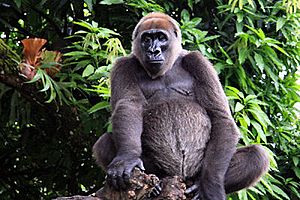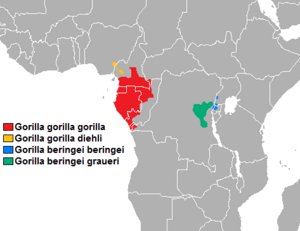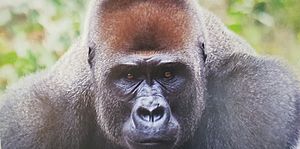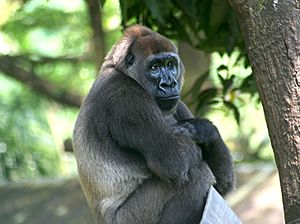Cross River gorilla facts for kids
Quick facts for kids Cross River gorillaTemporal range: Pleistocene to recent
|
|
|---|---|
 |
|
| Gorilla at the Limbe Wildlife Center in Cameroon | |
| Conservation status | |
| Scientific classification |
|
| Kingdom: | Animalia |
| Phylum: | Chordata |
| Class: | Mammalia |
| Order: | Primates |
| Suborder: | Haplorhini |
| Infraorder: | Simiiformes |
| Family: | Hominidae |
| Subfamily: | Homininae |
| Genus: | Gorilla |
| Species: | |
| Subspecies: |
G. g. diehli
|
| Trinomial name | |
| Gorilla gorilla diehli (Matschie, 1904)
|
|
 |
|
| Distribution range in yellow | |
The Cross River gorilla (Gorilla gorilla diehli) is a very rare type of western gorilla. It is considered critically endangered, meaning it is at high risk of disappearing forever. A scientist named Paul Matschie first identified it as a new species in 1904. However, detailed studies of these gorillas didn't begin until 1987.
These gorillas live in the forested hills and mountains along the border between Cameroon and Nigeria. They are found near the source of the Cross River (Nigeria). This group of gorillas is quite far from other gorilla populations. They are about 300 km (186 mi) away from western lowland gorillas and about 250 km (155 mi) from gorillas in the Ebo Forest.
In 2014, experts believed there were fewer than 250 adult Cross River gorillas left. This makes them the rarest great ape in the world. These gorillas tend to live in 11 main areas within a 12,000 km2 (4,633 sq mi) range. Recent studies show they might be found in even more places within this area. Genetic research also suggests that different groups of Cross River gorillas still connect with each other. In 2009, the Cross River gorilla was filmed by professionals for the first time in Cameroon.
Contents
About the Cross River Gorilla
The Cross River gorilla was first described in 1904. Scientists confirmed its unique features in 1987. By 2000, it was officially recognized as a distinct subspecies.
When compared to western lowland gorillas, Cross River gorillas have some differences. They have smaller palates (the roof of the mouth), smaller braincases, and shorter skulls. Their body size, and the length of their limbs and bones, are similar to western lowland gorillas. However, one study suggested they have shorter hands and feet.
Scientists have noted that Cross River gorillas have smaller teeth and skulls. They are not the largest gorillas, even though some older descriptions might have suggested that.
Here are some average measurements for adult Cross River gorillas:
- Average adult male height: 165 to 175 cm (5 ft 5 in to 5 ft 9 in).
- Average adult male weight: 140 to 200 kg (309 to 441 lb).
- Average adult female height: 140 cm (4 ft 7 in).
- Average adult female weight: 100 kg (220 lb).
How Cross River Gorillas Evolved
In 2000, scientists Esteban E. Sarmiento and John F. Oates suggested how the Cross River gorilla became a separate subspecies. They believe it happened during a dry period in Africa's past. At that time, food sources became scarce. This led the gorillas to eat more plants and spend more time on the ground.
The ancestors of the Cross River gorilla might have been isolated in forests near the Cross River. They may not have moved much from this area. The ancestors of the western lowland gorilla spread to the south or east, becoming a different group. There is no evidence that these two gorilla groups ever lived in the same places.
Where Cross River Gorillas Live
The Cross River gorilla prefers thick forests where humans do not live. Because of their size, they need large and varied forest areas to find enough food and shelter. Like many endangered animals, their natural homes are often places where humans also live and use natural resources.
The forests where these gorillas live can be found at different heights, from about 100 to 2,037 meters (328 to 6,683 ft) above sea level. Studies on Afi Mountain in Cross River State, Nigeria, helped scientists learn about their habitat. Researchers mapped habitat types, studied the climate, and looked at what foods were available. They also observed gorilla behavior, diet, and group patterns by studying things like feeding trails and nests.
Threats to Their Home
The homes of Cross River gorillas are badly affected by deforestation, which is the clearing of forests. This also leads to habitat fragmentation, where large forests are broken into smaller, separate pieces. These changes leave the gorillas with fewer places to live and find food.
Because many humans live in these areas, the gorillas have limited resources. Even though their land has shrunk, studies show there is still enough rainforest for them to survive for now. However, if humans continue to clear forests, these areas will keep getting smaller. Other human activities that harm gorillas include hunting, logging, farming, and collecting wood for fuel.
Gorillas need their habitat to survive. They are also large animals and have a slow rate of reproduction, which makes it harder for them to adapt to new environments. While there is limited research on Cross River gorillas, we know they can currently survive. The exact number of Cross River gorillas is still being debated.
Cross River gorillas are critically endangered and not fully studied. Their limited habitats mean they are about 200 km (124 mi) away from other gorilla groups. This area is near the Nigeria-Cameroon border, with mountains that limit where they can go. In the past, they lived in lowlands, but human activities pushed them into the hills. This reduced their access to food and land.
Most Cross River gorilla habitats are legally protected because they are so endangered. However, some areas, like those between Kagwene Mountain and Upper Mbulu, are not fully protected.
Cross River Gorilla Behavior
A study in 2007 found that Cross River gorillas sometimes fight back against human threats. They were seen throwing sticks and clumps of grass. This is unusual because gorillas usually run away or rarely charge when they meet humans.
Cross River gorillas build nests to sleep in. Their nesting habits depend on their habitat, the weather, how much food is available, and the risk of danger. In the Kagwene Gorilla Sanctuary, gorillas build nests in trees more often from April to November. From November onwards, they build more nests on the ground. Overall, more night nests are built on the ground.
They also build more nests during the wet season than the dry season. They build more tree nests in the wet season. Day nests are also more common, especially in the wet season. Gorillas often reuse nesting sites, no matter the season. A typical group nesting together has four to seven individuals. However, group size can vary by location.
Cross River gorilla groups usually have one male, six to seven females, and their young. Gorillas in lowland areas tend to have fewer babies than those in highlands. This might be due to more hunting and higher infant deaths in the lowlands. Highland groups are more crowded.
The Cross River gorilla's diet mainly includes fruit, leafy plants, vines, and tree bark. What they eat changes with the seasons. They seem to prefer fruit. But during the dry season, which lasts about four to five months, they eat other foods. They eat more vines and tree bark throughout the year, especially when fruit is scarce.
What They Eat
Cross River gorillas usually live in small groups of 4 to 7 individuals. Their diet is mostly fruit. However, during months when fruit is scarce (like August-September and November-January), they mainly eat ground-growing plants, bark, and tree leaves. Many of their food sources are seasonal. Their diets are rich in nutritious plants often found near their nesting sites.
For example, the Afi Mountain group mostly ate Aframomum herbs. But when available in the wet season, they preferred Amorphophallus difformis. This shows they have favorite foods that are seasonal and specific to their habitat.
How They Build Nests
The way Cross River gorillas build nests depends on their environment. This includes the climate, predators, available plants, and nearby seasonal fruits. They have specific nesting habits, like the size of their group in a nest, the style of the nest, its location, and if they reuse nests.
In a study at Kagwene Mountain, researchers found that the season greatly affects where nests are built. During the dry season, most nests were on the ground. But in the wet season, most nests were high in trees for protection from rain. They also built more day nests in the wet season. They reused nesting sites about 35% of the time. The average group size was 4 to 7 gorillas. However, the average number of nests at a site was 12.4, and often there were 13 nests. This suggests some gorillas might build more than one nest. Researchers even found sites with up to 26 nests, meaning multiple groups sometimes nested together.
Gorilla Aggression and Tools
Cross River gorillas at Kagwene Mountain in Cameroon have been seen using tools. This behavior seems unique to this group. In three separate cases, they threw grass or a detached branch at researchers. In another case, when a man threw rocks at them, they threw back handfuls of grass.
In these encounters, the gorillas first watched the researchers and made sounds. Then they became calm. Finally, male gorillas approached and threw grass. Researchers believe this throwing behavior might come from their contact with humans near farms. The gorillas' mixed reactions might be because local people do not hunt them due to old stories or folklore.
Where Cross River Gorillas Live (Distribution)
These gorillas live on the border between Nigeria and Cameroon. They are found in tropical and subtropical moist broadleaf forests. These forests are also home to the Nigeria-Cameroon chimpanzee, another type of great ape. The Cross River gorilla is the most western and northern gorilla. They live only in the forested hills and mountains of the Cameroon-Nigeria border region, near the source of the Cross River.
They are about 300 km (186 mi) away from the closest western lowland gorillas. They are also about 250 km (155 mi) from the gorilla population in the Ebo Forest of Cameroon. Groups of these gorillas focus their activities in 11 areas. These areas cover about 12,000 km2 (4,633 sq mi). Recent field studies have found gorillas outside these known areas, suggesting they might be spread wider. Genetic research supports this, showing that many Cross River gorilla groups still connect through occasional movement of individuals.
Cross River gorillas have been confirmed in several places. In Nigeria, they are in the Mbe Mountains and the Forest Reserves of Afi River, Boshi Extension, and Okwanggo. In Cameroon, they are in the Takamanda and Mone River Forest Reserves, and the Mbulu Forest. These locations form a mostly continuous forest area of about 8,000 km2 (3,089 sq mi) from Afi Mountain to Kagwene Mountain. This is based on a 2007 plan for their conservation. Experts also think there might be another group in the forests near Bechati. Today, their total population area is estimated to be about 12,000 km2 (4,633 sq mi). Cross River gorillas tend to stay in the Afi-to-Kagwene area because its rough, high terrain keeps them away from humans.
However, a 2013 study found that Cross River gorillas also live in lower areas, like the Mawambi Hills. This site is about 552 meters (1,811 ft) above sea level. This is much lower than their usual height of about 776 meters (2,546 ft).
Loss of Habitat
Cross River gorillas live in small groups, separated from other gorilla populations. They occupy about 14 distinct areas across 12,000 km2 (4,633 sq mi) of rough land on the Nigeria–Cameroon border. Population sizes are estimated at 75–110 in Nigeria and 125–185 in Cameroon. In the past, hunting was a bigger threat. Now, habitat loss is a much larger danger to their survival.
These gorillas live in undisturbed, dense forests. But such forests are rare because humans occupy them or use their resources. Most surviving gorillas live in Takamanda National Park and the Kagwene Gorilla Sanctuary. Gorillas avoid nesting in areas near humans, even within protected zones. While laws protect wildlife, Cross River gorillas still avoid human-disturbed areas. In 2017, a planned highway that would have harmed their habitat was rerouted.
Separated Groups
The growing human population and expanding grasslands (due to human activity) have split the gorillas into many smaller groups. Many factors, mostly related to human activity, have caused this separation. These include expanding farms, human settlements, and a lack of suitable habitat.
Because of this isolation, gorillas in different groups are not mixing their genes as much. This leads to a lack of genetic diversity, which could be a long-term problem. A study found that gene flow between western lowland and Cross River gorillas slowed down only about 400 years ago. This suggests that increasing human activities have made these ape populations more isolated. The recent drop in the Cross River gorilla population is likely due to more human pressure over the last few centuries.
Hunting Threats
The recent increase in hunting for bushmeat (wild animal meat) has greatly affected the gorilla population. Hunting seems to be more intense in lowland areas. This may have caused gorillas to move to highlands and contributed to their small population sizes. Even though hunting is against the law, it still happens for local food and trade to other countries.
These laws are often not enforced well. Because there are so few Cross River gorillas, any hunting has a huge impact on their survival. All hunting of this population is unsustainable, meaning it cannot continue without the gorillas disappearing.
Why Their Numbers Are Declining
The number of Cross River gorillas dropped by 59% between 1995 and 2010. This is a greater decline than any other great ape subspecies during that time. Apes like the Cross River gorilla show us when there are problems in their environment. They also help other species survive. Their decline began 30 years ago and continues at an alarming rate. Hunters have made these gorillas fear humans, so seeing a Cross River gorilla is rare.
Cross River gorillas try to avoid nesting in grasslands and farms. This causes the remaining forest to become fragmented. When habitats are broken up, it reduces or stops gorillas from moving between groups. This leads to more inbreeding within a single group, which means a loss of genetic diversity. This negatively affects the long-term health of these small groups and the entire population.
Researchers use genetic methods to understand the Cross River gorilla population better. Surveys suggest there are about 300 individuals. They are split across about ten locations with limited breeding contact. Besides habitat fragmentation, Cross River gorillas are also threatened by hunting for bushmeat and for their bones, which are used for unproven medical purposes. Some local communities have old beliefs that protect certain primates. They might see them as sacred or use them in traditional medicine.
Another threat is the harmful gorilla pet trade. So far, only one Cross River gorilla has been recorded in captivity, at the Limbe Wildlife Center. Even though this number is small, the pet trade has threatened other gorilla species in the past. It will likely endanger the Cross River gorilla too. Baby gorillas are often preferred as pets, so hunters will kill the adult gorillas protecting them.
The Cross River gorilla is critically endangered due to hunting and the risk of Ebola infection. Even if hunting and Ebola deaths were reduced, a quick recovery is unlikely. The Cross River gorilla reproduces slowly. It is estimated it would take 75 years for the population to fully recover. They are also threatened by habitat loss from mining, farming, and logging.
Despite these challenges, conservationists are hopeful. They filmed several adult and baby gorillas in spring 2020, which was a positive sign.
Protecting the Cross River Gorilla
All western gorillas are Critically Endangered, partly due to the Ebola virus. But the Cross River gorilla is the most endangered African ape. A 2014 survey estimated fewer than 250 mature individuals were left in the wild. However, a 2012 survey did not include the Cross River gorilla on "The World’s 25 Most Endangered Primates List." To help other species, scattered populations are sometimes brought together to prevent inbreeding.
A problem for Cross River gorillas is that they are surrounded by human populations. These humans cause threats like bushmeat hunting and habitat loss. Also, their protected habitats along the Nigeria-Cameroon border are close to hunting areas. This increases the risk of extinction. The Cross River gorilla is very important to the ecosystem. They help spread seeds for certain tropical plants that might otherwise disappear.
In 2007, a survey in 5 villages looked at local beliefs against hunting these endangered species. In the Lebialem area of Cameroon, 86% of people supported gorilla conservation. They saw gorillas as important to humans. They believed that if gorillas died out, it would harm their own culture. Some thought that younger people not following these old traditions was a reason for the decline. However, these beliefs still strongly discourage hunting. These traditions are seen as key to the gorillas' survival. Bringing back these beliefs can help conservation, especially where laws are not well enforced. While this can also help communities and culture, care must be taken as some practices could encourage killing. Because of these beliefs, there have been no Cross River gorilla hunting incidents in the past 15 years. This local conservation strategy has been very successful.
In April 2001, the Wildlife Conservation Society and the Nigerian Conservation Foundation held a workshop in Nigeria. The goal was to improve the gorillas' chances of survival because they are so rare and unique. The workshop suggested improvements to save the species. It also highlighted the need for regular meetings between the governments and conservation groups of Cameroon and Nigeria. This would make their conservation efforts more effective.
In 2008, the government of Cameroon created the Takamanda National Park on the border with Nigeria. This was to protect these gorillas. The park is now part of a large protected area that crosses the border into Nigeria’s Cross River National Park. This area protects an estimated 115 gorillas, which is one-third of the Cross River gorilla population. It also protects other rare species. The hope is that gorillas can move freely between the Takamanda reserve in Cameroon and Nigeria's Cross River National Park.
The Kagwene Gorilla Sanctuary was created by the Cameroonian government on April 3, 2008. It is part of the IUCN’s plan for Cross River gorilla conservation. It protects 19.44 km2 (7.5 sq mi) of land. It is located between the Mbulu and Nijikwa forests in western Cameroon. The sanctuary has rough, mountainous terrain. It includes the highest areas where Cross River gorillas live, with the highest point at 2,037 meters (6,683 ft) above sea level. Only about half of its land is good gorilla habitat. The rest is grassland or farmed land, which is not suitable. Because it is a sanctuary, it was expected to have a conservator and eco-guards to enforce wildlife laws.
Images for kids
See also
 In Spanish: Gorila occidental del río Cross para niños
In Spanish: Gorila occidental del río Cross para niños








